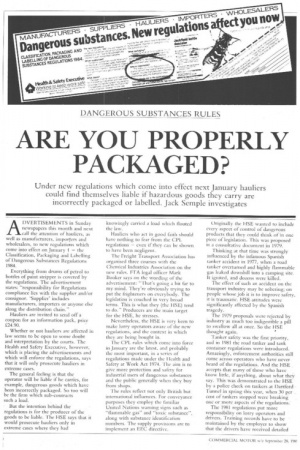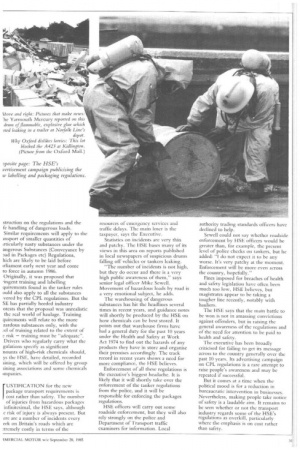ARE YOU PROPERLY PACKAGED?
Page 32

Page 33

If you've noticed an error in this article please click here to report it so we can fix it.
Under new regulations which come into effect next January hauliers could find themselves liable if hazardous goods they carry are incorrectly packaged or labelled. Jack Semple investigates
ADVERTISEMENTS in Sunday newspapers this month and next call the attention of hauliers, as well as manufacturers, importers and wholesalers, to new regulaticms which come into effect on January 1 — the Classification, Packaging and Labelling of Dangerous Substances Regulations 1984.
Everything from drums of petrol to bottles of paint stripper is covered by the regulations. The advertisement states: "responsibility for Regulations compliance lies with the supplier and/or consignor. 'Supplier' includes manufacturers, importers or anyone else along the distribution chain."
Hauliers are invited to send off a coupon for an information pack, price £24.90.
Whether or not hauliers are affected in law seems to be open to some doubt and interpretation by the courts. The Health and Safety Executive, however, which is placing the advertisements and which will enforce the regulations, says that it will only prosecute hauliers in extreme cases.
The general feeling is that the operator will be liable if he carries, for example, dangerous goods which have been incorrectly packaged. So too will be the firm which sub-contracts such a load. .
• But the intention behind the regulations is for the producer of the goods to be liable. The EISE says that it would prosecute hauliers only in extreme cases where they had knowingly carried a load which flouted the law.
Hauliers who act in good faith should have nothing to fear from the CPL regulations — even if they can be shown to have been negligent.
The Freight Transport Association has organised three courses with the Chemical Industries Association on the new rules. FTA legal officer Mark Booker says on the wording of the advertisement: "That's going a bit far to my mind. They're obviously trying to put the frighteners on everybody. The legislation is couched in very broad terms. This is what they (the HSE) tend to do." Producers are the main target for the HSE, he stresses.
Nevertheless, the HSE is very keen to make lorry operators aware of the new regulations, and the context in which they are being bought in.
The CPL rules which conic into force in January are the latest, and probably the most important, in a series of regulations made under the I lealth and Safety at Work Act 1974. The aim is to give more protection and safety for industrial users of dangerous substances and the public generally when they buy from shops.
The rules reflect not only British but international influences. For conveyance purposes they employ the familiar United Nations warning signs such as "flammable gas" and "toxic substance", along with substance identification numbers. The supply provisions are to implement an EEC directive. Originally the HSE wanted to include every aspect of control of dangerous products that they could think of in one piece of legislation. This was proposed in a consultative document in 1979.
Thinking at that time was strongly influenced by the infamous Spanish tanker accident in 1977, when a road tanker overturned and highly flammable gas leaked downhill into a camping site. It ignited, and dozens were killed.
The effect of such an accident on the transport industry may be sobering; on people whose job it is to improve safety, it is traumatic. HSE attitudes were significantly affected by the Spanish tragedy.
The 1979 proposals were rejected by industry as much too indigestible a pill to swallow all at once. So the IISE thought again.
'Tanker safety was the first priority, and in 1981 the road tanker and tank container regulations were introduced. Amazingly, enforcement authorities still come across operators who have never heard of the regulations. And the HSE accepts that many of those who have • know little, if anything, about what they say. This was demonstrated to the HSE by a police check on tankers at Dartford Tunnel in spring this year, when 30 per cent of tankers stopped were breaking one or more aspects of the regulations: The 1981 regulations put more responsibility on lorry operators and drivers. Training records have to be maintained by the employer to show that the drivers have received detailed
struction on the regulations and the fe handling of dangerous loads. Similar requirements will apply to the msport of smaller quantities of vicularly nasty substances under the angerous Substances (Conveyance by Dad in Packages etc) Regulations, hich are likely to be laid before irliament early next year and come to force in autumn 1986.
Originally, it was proposed that -ingent training and labelling quirements found in the tanker rules ould also apply to all the substances Yered by the CPL regulations. But the SE has partially heeded industry °tests that the proposal was unrealistic the real world of haulage. Training quirements will relate to the more zardous substances only, with the Tel of training related to the extent of risk — training must be "adequate". Drivers who regularly carry what the gulations specify as significant nounts of high-risk chemicals should, ys the FISE, have detailed, recorded lining, which will be offered by group lining associations and some chemicals ,mpanies.
[USTIFICATION for the new package transport requirements is cost rather than safety. The number of injuries from hazardous packages infinitesimal, the HSE says, although e risk of injury is always present. But ere are a number of incidents every eek on Britain's roads which are :tremely costly in terms of the
resources of emergency services and traffic delays. The main loser is the taxpayer, says the Executive.
Statistics on incidents are very thin and patchy. The HSE bases many of its views in this area on reports published in local newspapers of suspicious drums falling off vehicles or tankers leaking.
"The number of incidents is not high, but they do occur and there is a very high public awareness of them," says senior legal officer Mike Sewell. Movement of hazardous loads by road is a very emotional subject, he adds.
The warehousing of dangerous substances has hit the headlines several times in recent years, and guidance notes will shortly be produced by the HSE on how chemicals can be best stored. It points out that warehouse firms have had a general duty for the past 10 years under the Health and Safety at Work Act 1974 to find out the hazards of any products they have in store and organise their premises accordingly. The track record in recent years shows a need for more compliance, the HSE believes.
Enforcement of all these regulations is the executive's biggest headache. It is likely that it will shortly take over the enforcement of the tanker regulations from the police, and it will be responsible for enforcing the packages regulations.
HSE officers will carry out some roadside enforcement, but they will also rely strongly on the police and Department of Transport traffic examiners for information. Local authority trading standards officers have declined to help.
Sewell could not say whether roadside enforcement by HSE officers would be greater than, for example, the present level of police checks on tankers, but he added: "I do not expect it to be any worse. It's very patchy at the moment. Enforcement will be more even across the country, hopefully."
Fines imposed For breaches of health and safety legislation have often been much too low, HSE believes, but magistrates appear to be taking a tougher line recently, notably with hauliers.
The HSE says that the main battle to be won is not in amassing convictions against offenders, but in raising the general awareness of the regulations and of the need for attention to be paid to health and safety.
The executive has been broadly criticised for failing to get its message across to the country generally over the past 10 years. Its advertising campaign on CPL regulations is a rare attempt to raise people's awareness and may be repeated if successful.
But it conies at a time when the political mood is for a reduction in bureaucratic intervention in businesses. Nevertheless, making people take notice of safety is a laudable aim. It remains to be seen whether or not the transport industry regards some of the HSE's regulations as overkill, particularly where the emphasis is on cost rather than safety.




























































































